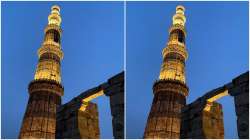Qutab Minar Controversy: All things that you should know about one of the tallest buildings in the world
Qutab Minar or Qutb Minar, also known as Qutab Minar is a minaret which is a part of the Qutb Minar complex situated in South Delhi, India. There are so many theories around the building of this structure. Let's have a look at some interesting facts about the monument.

Qutab Minar Controversy: After the Taj Mahal and Gyanvapi Masjid controversies, the construction of Qutub Minar has attracted a lot of eyeballs. According to the new claim made by a former ASI officer, Qutub Minar was built by Raja Vikramaditya and not by Qutv-AL-Din Aibak. He claimed that Qutub Minar was a “sun tower” that was built by Chandragupta Vikramaditya of the Gupta Empire in the 5th Century.
The Archaeological Survey of India was asked to survey the site and it claimed that Qutub Minar is not a place of worship, nor can it be revived as one under the laws of the land. A Delhi court has reserved its order for June 9 on pleas to restore the right to worship at the Quwwat-Ul-Islam mosque in the monument’s premises for Hindus and Jains. As the controversy continues, let's take a look at what is the history of Qutab Minar.
Also Read: On reports claiming excavation at Qutub Minar complex, Centre's reply
Who built Qutub Minar?
According to history, Qutub Minar was built as an Islamic monument back in the 13th century in South Delhi, India. This superstructure was commenced by Qutubuddin Aibak in 1193, under his rule only the first floor was built. As the next ruler Shams-ud-din Iltutmish became the sultan of Delhi, he ordered to make three more floors. After which Firoz Shah Tughlak built the fifth and the last floor in 1368. Overall its construction took almost 28 years.
The architecture of Qutub Minar
Qutub Minar is one of the tallest towers in India and is 238 ft tall, consisting of five storeys. The minaret has 379 staircases to reach the top. This beautiful tower is made of red sandstone and marble in an Indo-Islamic style. Verses of Islamic holy book Quran was written on the walls of Qutub Minar.
Qutub Minar repairing and maintenance
Records in History state that in the year 1505, Qutab Minar was damaged by an earthquake and lighting. It was repaired by one of the rulers of the Lodhi Dynasty, Nizam Khan who is famously known as Sikandar Lodhi. Now, this majestic tower comes under the heritage site of UNESCO and it takes care of its maintenance.
Qutab Minar and small monuments surrounding it
Qutab Minar’s surrounding areas have lush green gardens. According to records, there is Alai-Darwaza Gate which was built in 1311 and a mosque, which is one of the oldest mosques situated in the same compound with the minaret knowns as Quwwat-Ul-Islam. There is an iron pillar standing near the area of Qutab Minar, which stood the test of time and never rusted in 200 years.
Also Read: Qutub Minar row: ASI says sculptures exist within complex, but against namaz, puja at monument
The popularity of Qutab Minar
Qutab Minar became a world heritage site by UNESCO in 1993. It welcomes thousands of visitors every yea. It is also one of the most popular monuments in India.
Past controversies of Qutab Minar
The tall structure is now home to several controversies that have been the topic of discussions every now and then.
In April this year, the National Museum Authority asked the Archaeological Survey of India to remove two Ganesha Idols from the Qutub Minar and find a place for them at the National Museum. After which court ordered not to remove the idols from its original place.
Another controversy on the world heritage site happened when the Vishwa Hindu Parishad (VHP) claimed that Qutub Minar was a ‘Vishnu Stambh’ before some Muslim rulers reconstructed it. Vinod Bansal, National spokesperson of VHP claimed that the Qutub Minar was built by demolishing 27 Hindu-Jain temples to tease the Hindu community.
A few weeks ago, members of the right-wing group reached the Qutub Minar with the saffron flag and recited the Hanuman Chalisa at the Qutub Minar Complex. They demanded to rename the iconic structure as ‘Vishnu Stambh’.
